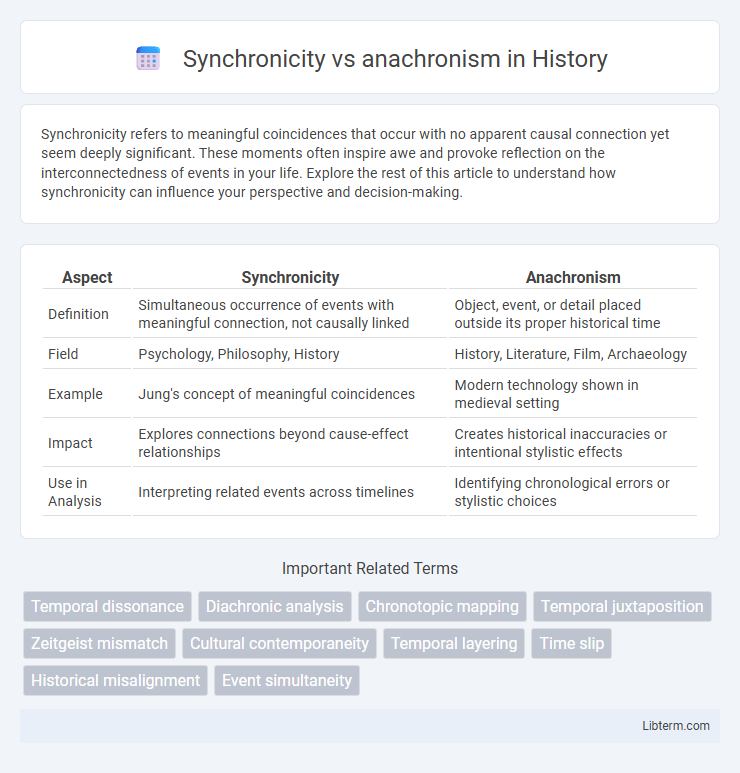Synchronicity refers to meaningful coincidences that occur with no apparent causal connection yet seem deeply significant. These moments often inspire awe and provoke reflection on the interconnectedness of events in your life. Explore the rest of this article to understand how synchronicity can influence your perspective and decision-making.
Table of Comparison
| Aspect | Synchronicity | Anachronism |
|---|---|---|
| Definition | Simultaneous occurrence of events with meaningful connection, not causally linked | Object, event, or detail placed outside its proper historical time |
| Field | Psychology, Philosophy, History | History, Literature, Film, Archaeology |
| Example | Jung's concept of meaningful coincidences | Modern technology shown in medieval setting |
| Impact | Explores connections beyond cause-effect relationships | Creates historical inaccuracies or intentional stylistic effects |
| Use in Analysis | Interpreting related events across timelines | Identifying chronological errors or stylistic choices |
Understanding Synchronicity: Definition and Origins
Synchronicity refers to meaningful coincidences that occur with no causal relationship yet seem significantly related. Coined by psychologist Carl Gustav Jung, the concept explores the connection between events linked by meaning rather than cause and effect. Understanding synchronicity involves recognizing these occurrences as reflections of an underlying order beyond linear time constraints.
What is Anachronism? Meaning and Examples
Anachronism refers to a chronological inconsistency where objects, events, or customs are placed outside their proper historical timeline, causing a temporal mismatch. Examples include a character in a Shakespearean play using a modern smartphone or a medieval painting depicting a wristwatch, highlighting the error in time context. Recognizing anachronisms is crucial in literature, film, and art to maintain historical accuracy and authenticity.
The Philosophical Context: Synchronicity vs Anachronism
Synchronicity in philosophy refers to meaningful coincidences that reveal connections beyond causality, often associated with Jungian thought, highlighting the interplay of time and consciousness. Anachronism denotes the misplacement of events, ideas, or objects in a temporal context where they do not belong, challenging historical accuracy and interpretation. The philosophical context contrasts synchronicity's emphasis on temporal interconnectedness with anachronism's disruption of chronological order, illuminating different ways of understanding time and meaning.
Synchronicity in Literature and Art
Synchronicity in literature and art refers to the meaningful coincidence of events and symbols that enhance thematic depth and narrative complexity, often linking characters and motifs across different layers of a work. This concept, rooted in Carl Jung's theory, allows creators to explore the unconscious connections between disparate elements, enriching viewer or reader engagement through non-linear and symbolic associations. By weaving synchronicity into plot and visual symbolism, artists and writers invite audiences to perceive reality beyond chronological constraints, fostering profound interpretations.
Anachronism as a Creative Device
Anachronism as a creative device intentionally places objects, ideas, or events outside their proper historical context to provoke thought and highlight contrasts in storytelling. This technique enriches narratives by blending past and present elements, fostering unique interpretations and critical reflection on cultural or temporal shifts. Writers and artists use anachronism to challenge linear perceptions of time, thereby enhancing thematic depth and audience engagement.
Differences Between Synchronicity and Anachronism
Synchronicity refers to meaningful coincidences where events occur simultaneously or in a related timing without causal connection, often interpreted as significant or symbolic, while anachronism denotes an error in chronological placement where an object, event, or detail is out of its proper historical time. The key difference lies in synchronicity emphasizing temporal alignment and meaningful patterns, whereas anachronism highlights temporal displacement or historical inaccuracy. Synchronicity is often linked to psychological or metaphysical contexts, whereas anachronism is primarily a concept in history, literature, and cultural analysis.
Impact of Synchronicity on Modern Culture
Synchronicity, a concept introduced by Carl Jung, profoundly influences modern culture by shaping narratives in literature, film, and art that explore meaningful coincidences and interconnectedness. Its impact is evident in the rising popularity of themes emphasizing fate, collective unconscious, and the interplay between time and events in contemporary storytelling and spiritual movements. This phenomenon challenges linear perceptions of time, encouraging audiences to embrace complexity and interconnected realities within cultural expressions.
Famous Historical Anachronisms
Famous historical anachronisms reveal discrepancies where objects, events, or ideas appear out of their proper chronological context, such as the use of wristwatches in ancient Roman settings or modern technology in period films. These anachronisms challenge the accuracy of historical representation and highlight the importance of synchronizing timelines to maintain authenticity in storytelling and academic work. Examples like the depiction of dinosaurs coexisting with humans in popular media underscore the impact of ignoring synchronicity in history.
Synchronicity and Anachronism in Film and Media
Synchronicity in film and media refers to the meaningful alignment of events or themes occurring simultaneously, enhancing narrative depth and audience engagement. Anachronism, conversely, involves placing elements out of their historical or chronological context, which can either serve as a deliberate artistic device or result in unintentional inaccuracies that disrupt immersion. Both techniques influence storytelling by shaping viewers' perceptions of time, authenticity, and thematic resonance within cinematic and media experiences.
Interpreting Time: Lessons from Synchronicity and Anachronism
Interpreting time through synchronicity reveals meaningful coincidences that transcend linear chronology, highlighting how events connect across different moments. Anachronism challenges this by exposing temporal dislocations, where objects or ideas appear out of their historical context, prompting reevaluation of cultural and historical understanding. Together, synchronicity and anachronism underscore the fluidity of time perception and the importance of contextual awareness in historical interpretation.
Synchronicity Infographic

 libterm.com
libterm.com